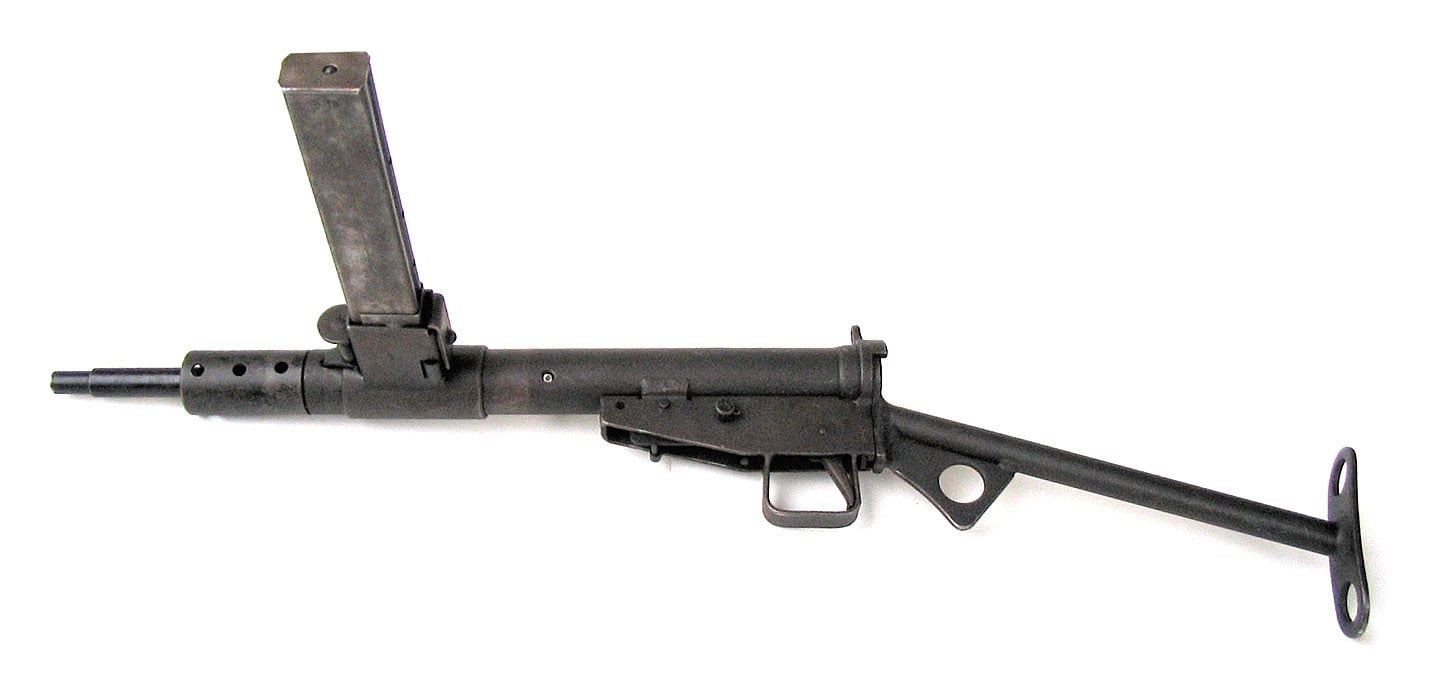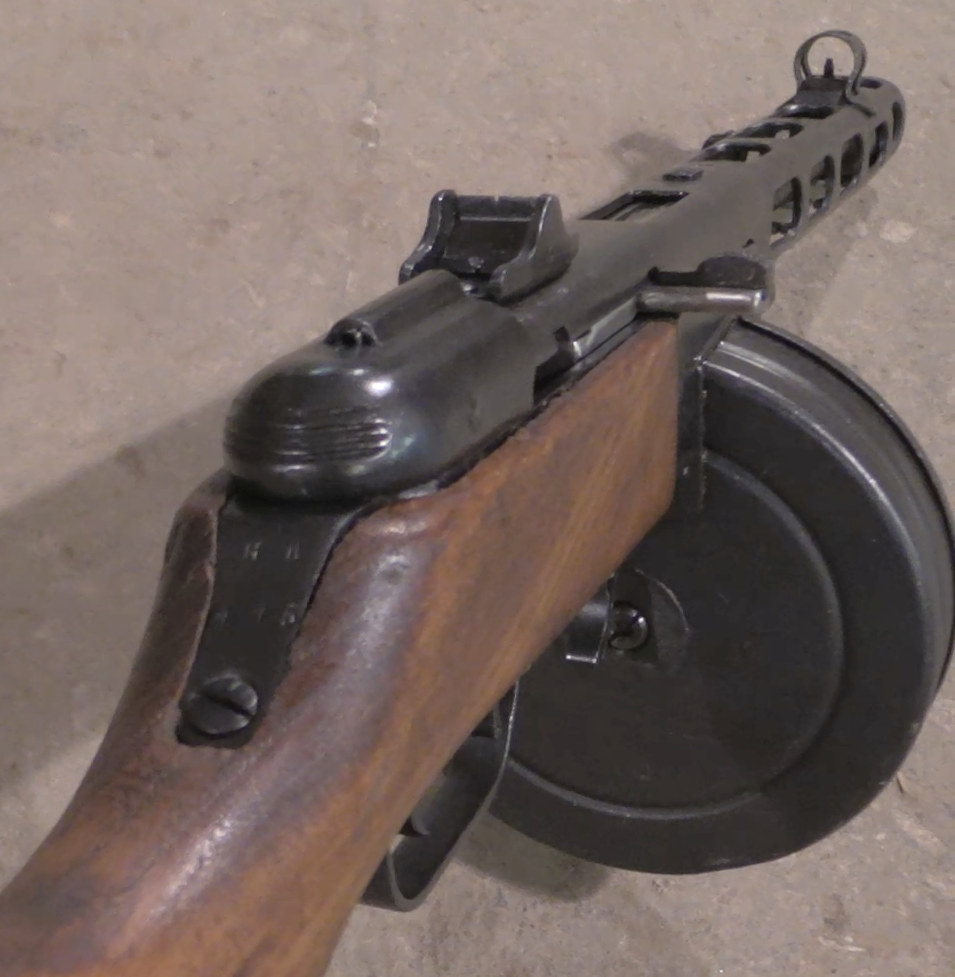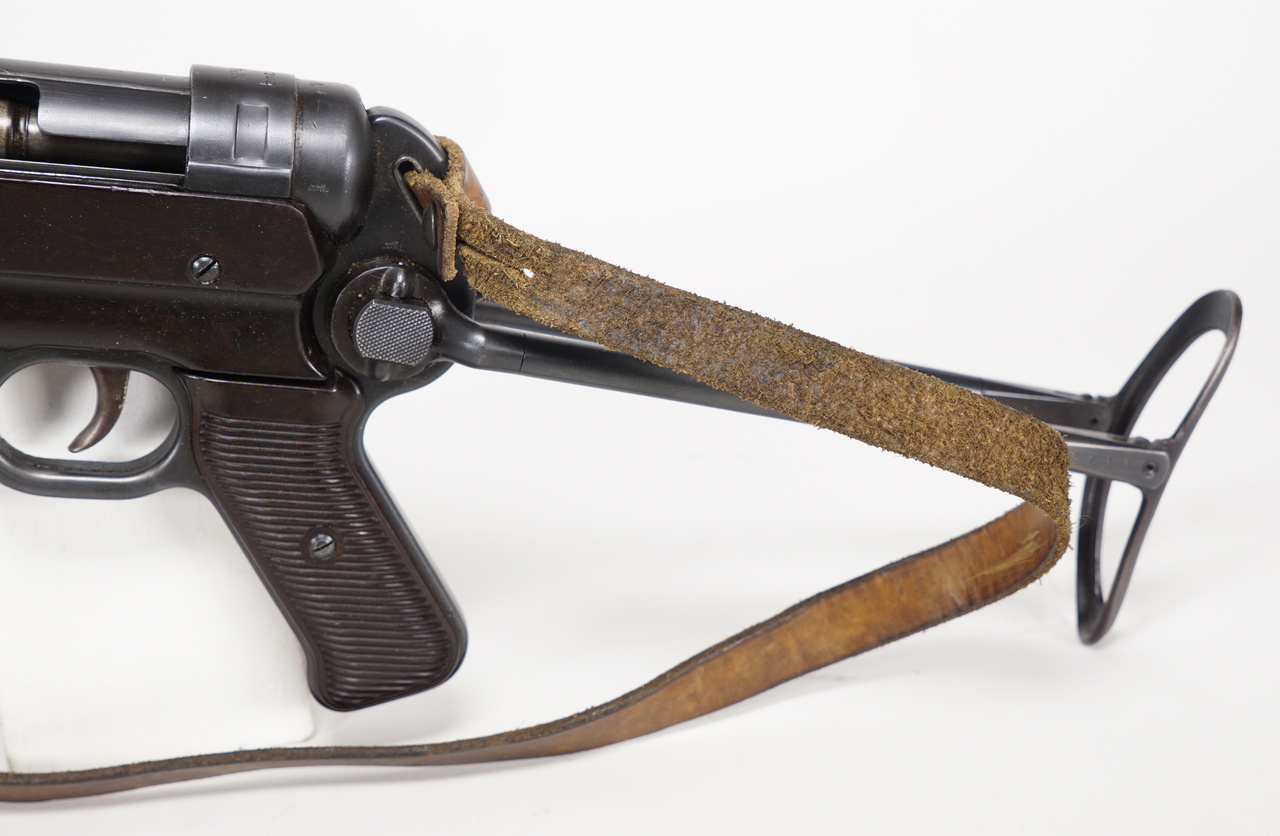German Burp Gun - The PPSh-41 (Russian: Пистоле́т-пулемёт Шпа́гина, tr. Pistolét-pulemyót Shpagina-41, lit. 'Shpagin's machine-pistol-41') is a Soviet submachine gun designed by Georgy Shpagin as a cheap alternative. -40. A common Russian nickname for the weapon is "papasha" (папа́ша), meaning "father",
The PPSh is a selective-fire submachine gun using a bolt op, blowback action. Made mostly of stamped steel, it can be filled with boxes or drum magazines and fire Tokarev 7.62 × 25mm pistols.
German Burp Gun

The PPSh saw extensive combat use during World War II and the Korean War; in Eastern Bloc countries, monuments commemorating the actions of the Red Army often feature a PPSh-41.
Teutonic Titan: German Mp40
It became one of the main infantry weapons of the Soviet Armed Forces during World War II, with around six million PPSh-41s produced during this time, making it the most produced machine gun of the war. In its Chinese Type 50 form (a licensed copy), it continued to be used with the Viet Cong until 1970 and continues to be used with irregular military personnel.
The impetus for the development of the PPSh came in part from the Winter War against Finland, where the Finnish Army employed the Suomi KP/-31 submachine gun as a highly effective tool for hand-to-hand combat in forests and urban built-ups. area. The 71-round battery magazine was later copied and adopted by the Soviets for their PPD-40 and PPSh-41 submachine guns.
The PPD-40 was subsequently launched into mass production in 1940, but was expensive to produce, both in terms of materials and workmanship, as it used several milled metal parts, especially the receiver. Georgy Shpagin's main idea to reduce costs is to use metal stamping for the production of most parts. Shpagin created the PPSh prototype in September 1940, which also featured a simple gas compensator designed to prevent the barrel from rising during firing; This increased the photo group by about 70% over PPD.
These new weapons are produced in a network of factories throughout Moscow, and high-ranking local Party members are directly responsible for meeting production targets. Several hundred weapons were produced in November 1941 and another 155,000 were made over the next five months. In the spring of 1942, the PPSh factory produced approximately 3,069 units per day.
What Russia, North Korea And China Have In Common: Millions Of These Machine Guns
Its parts (including barrels) can be produced by relatively unskilled labor with simple tools available in machine shops or body shops, freeing up skilled workers for other tasks. The PPSh-41 uses 87 components compared to 95 for the PPD-40 and the PPSh can be manufactured in an estimated 5.6 machining hours (later revised to 7.3 hours) compared to 13.7 hours for the PPD.
Barrel production is often simplified by using a barrel for the 7.62 mm Mosin-Nagant: the rifle barrel is cut in half and two PPSh barrels are made from it after machining for the 7.62 × 25 mm Tokarev cartridge.
After the German Army captured a large number of PPSh-41 during the Second World War, a program was established to convert the weapon to the standard German submachine gun cartridge - 9 × 19 mm Parabellum. The Wehrmacht officially adopted the PPSh-41 changed to "MP41 (r)"; the unconverted PPSh-41s are designated "MP717 (r)" and are supplied with 7.63 × 25mm Mauser ammunition (which is dimensionally identical to the 7.62 × 25mm Tokarev but slightly less powerful). A German language manual for the use of captured PPShs was printed and distributed in the Wehrmacht.

In addition to replacing the barrel, the PPSh-41 was also modified to install a magazine adapter, allowing the use of the MP 40 magazine. Less powerful 9mm ammo generally reduces the cyclic rate of fire from 800 to 750 RPM. Modern aftermarket conversion kits based on the original Wehrmacht are also available using a variety of magazines including the St. Some thoiasts managed to make it work with original Soviet drums and drumsticks, eliminating the adapter, as well as the use of more powerful Winchester 9 × 23mm ammunition.
A Little Larger Firearm Than The Owa
As standard, each PPSh-41 comes with two factory-fitted drum magazines that match the weapon with a stamped serial number. If battery cartridges are mixed and used with different PPSh-41 serial numbers, loose fit may cause poor retention and power failure. The drum magazine was replaced by a simpler PPS-42 box-type magazine with 35 rounds, although an improved drum magazine made of 1 mm thick steel was also introduced in 1944.
The PPS-43 was later introduced into Soviet service in 1943, which was even more basic in its design than the PPSh and had a more moderate rate of fire, but did not replace the PPSh-41 during the war.
The Soviet Union also experimented with the PPSh-41 in the antipersonnel close air support role, mounting dozens of submachine guns on the forward fuselage rack in the Tu-2sh variant of the Tupolev Tu-2 bomber.
More than five million PPSh machine guns were produced at the end of the war. The Soviets are often equipped with platoons and sometimes tired companies with weapons, giving them excellent short-range firepower.
Ugly But Effective: How The Sten Gun Became A Wwii Workhorse
Thousands more were left behind enemy lines to equip Soviet partisans to disrupt German supply lines and communications.
Soviet PPSH-41 submachine gun, Fort Lewis Military Museum, Fort Lewis, Washington, USA Part of a Korean War weapons exhibit.
After World War II, PPSh was supplied in large quantities to the Soviet-aligned countries and communist guerilla forces. During the Korean War, the Korean People's Army (KPA) and the Chinese People's Volunteer Army (PVA) fighting in Korea received large numbers of PPSh-41s in addition to the North Korean Type 49 and the Chinese Type 50, both licensed copies of the PPSh-41 with minor mechanical revisions.

Although relatively inaccurate, the Chinese PPSh has a high rate of fire and is well-suited for close range firefights that typically occur, especially at night.
M3 Submachine Gun
UN troops at defensive posts or on patrol often had trouble returning a sufficient amount of fire when attacked by infantry companies armed with PPSh. Some US infantry officers rank the PPSh as the best combat weapon in the war: while it lacks the accuracy of the US M1 Garand and M1 carbine, it provides more firepower at close range.
Captain of the infantry (later General) Hal Moore, stated, "in automatic mode it fired a lot of bullets and most of the killing in Korea was done at close range and it was done quickly - the question is about who responds quickly. In a situation like that. overcame and overcame what we had. A close patrol war ended very quickly and we usually lost because of it.
The US military, however, felt that their M2 carbines were superior to the PPSh-41 at a range of only 100 to 150 meters typical.
The PPSh-41 fires the standard Soviet pistol and submachine gun cartridge, the Tokarev 7.62×25 mm. It weighs about 12 pounds (5.45 kg) with a loaded 71-round drum and 9.5 pounds (4.32 kg) with a loaded 35-round boxloader. PPSh is capable of a speed of about 1250 rounds per minute,
The Forgotten Ruger Mp9 Room Broom
Very high rate of fire compared to most other World War II military submachine guns. It is a durable, low maintenance weapon made from readily available, low cost components, mainly stamped sheet metal and wood. Final production PPShs have superior ejection and L-type rear sights that can be adjusted for ranges of 100 and 200 meters. A dirty compensator is built into the jacket of the barrel, intended to reduce the rise of the barrel during automatic firing. Compsator was moderately successful in this regard, but greatly increased muzzle flash and gun report. The PPSh also has a hinged receiver for easy removal and cleaning of the gun.
The chrome-plated bore allows the PPSh to withstand corrosive ammunition and long intervals between cleanings. No front or hand grips are provided, and the operator usually has to hold the gun behind the drum magazine with a supporting hand, or else hold the lower edge of the drum magazine. Although 35-round curved box magazines were available from 1942 onwards, the average Soviet infantryman in World War II carried the PPSh with the original 71-round battery magazine.
Although the PPSh battery charger contains 71 rounds, it is possible to misfeed with more than 65 rounds.

In addition to feeding problems, the drum magazine is slower and more difficult to load ammunition than the later 35-round magazine box, which is increasingly supplemented by the drum after 1942. Although it contains fewer rounds, the magazine box has the advantage of providing excellent. the ability to hold with the supporting hand. Although this PPSh is equipped with a safety sliding bolt, the operational bolt design of our weapon still presents the risk of accidental discharge if the weapon is dropped on a hard surface.
Madsen Machine Gun
Wehrmacht Feldwebel Wilhelm Traub armed with a PPSh-41 explores the view of Stalingrad in the middle of the ruined city in the fall of 1942. The ruined city is now known as Gagarin Park.
Red Army soldiers armed with PPSh-41 take German soldiers captive after the Battle of Stalingrad, 1943. World War II changed everything about life on planet Earth. At that time, 56 million people lost their lives, and the technology derived from the war projects revolutionized everything from engineering to material science.
German grease gun, german flare gun holster, german sport gun, mattel burp gun, german railway gun, mattel thunder burp toy machine gun, thunder burp toy gun for sale, tommy burp toy gun, mattel thunder burp gun, drilling gun german, toy burp gun, german gun ww2
0 Comments